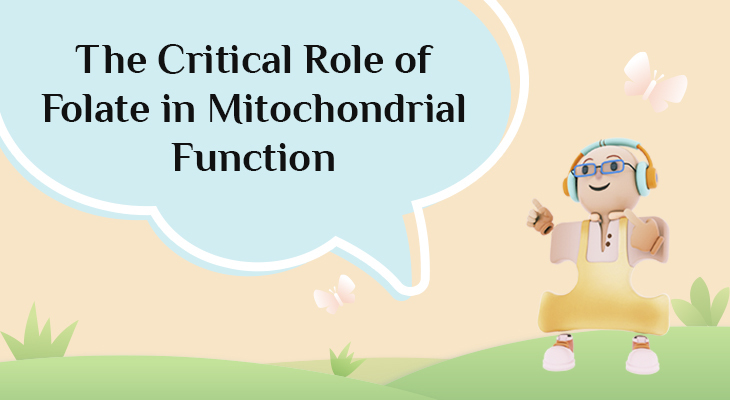
Introduction
Folate (vitamin B9) is a water-soluble vitamin that plays a fundamental role in cellular metabolism, particularly in mitochondrial function. Mitochondria, often referred to as the “powerhouses of the cell,” are responsible for generating adenosine triphosphate (ATP) through a process known as oxidative phosphorylation. Folate contributes to mitochondrial efficiency by supporting one-carbon metabolism, nucleotide synthesis, and redox balance. Folate is a critical nutrient as it affects the biochemical pathways that influence mitochondrial function.
Folate and One-Carbon Metabolism in Mitochondria
Folate exists in several forms, with tetrahydrofolate (THF) being the most biologically active. THF serves as a carrier for one-carbon (C1) units, which are essential for:
- Purine and Pyrimidine Synthesis – Folate-derived C1 units contribute to the synthesis of nucleotides (ATP, GTP, TTP, CTP), which are critical for mitochondrial DNA (mtDNA) replication and repair.
- Amino Acid Metabolism – Folate is involved in the interconversion of serine and glycine via the mitochondrial folate cycle, which provides methyl groups for methylation reactions.
- Methionine Cycle and S-Adenosylmethionine (SAMe) Production – The mitochondrial folate cycle interacts with the methionine cycle to produce SAMe, a universal methyl donor necessary for epigenetic regulation and mitochondrial protein function.
The mitochondrial folate cycle is distinct from the cytosolic folate cycle, emphasizing folate’s unique role in mitochondrial metabolism.
As mentioned prior, folate refers to a family of related compounds (B-9 vitamers) that differ in their oxidation state, one-carbon substitutions, and glutamate tail length. Key forms include:
- Folic acid (fully oxidized synthetic form, used in supplements/fortification).
- Dihydrofolate (DHF) (partially reduced).
- Tetrahydrofolate (THF) (fully reduced, biologically active carrier of one-carbon units).
- 5-Methyltetrahydrofolate (5-MTHF) (major circulating form in blood).
- 5-Formyltetrahydrofolate (folinic acid/leucovorin) (stable reduced form used clinically).
- 10-Formyl-THF, 5,10-Methylene-THF, etc. (one-carbon substituted derivatives).
Tetrahydrofolate is the central and functionally active form because it is the direct acceptor and donor of one-carbon units in key metabolic pathways (e.g., nucleotide synthesis, methylation). It is the substrate for enzymes like thymidylate synthase (DNA synthesis) and methionine synthase (methylation).
However, 5-MTHF (the predominant circulating form) is also highly active because it is the immediate precursor for homocysteine re-methylation to methionine. Unlike folic acid, it bypasses defects in the MTHFR enzyme (a common genetic polymorphism).
Folate, Oxidative Stress, and Mitochondrial Redox Balance
Mitochondria are major sources of reactive oxygen species (ROS), which, in excess, can damage mtDNA, lipids, and proteins. Folate helps maintain mitochondrial redox balance by supporting glutathione synthesis. Folate metabolism also contributes to the production of glutathione (GSH), a key antioxidant that neutralizes ROS in mitochondria. Additionally, folate prevents homocysteine accumulation. Folate deficiency, in fact, leads to elevated homocysteine, which induces oxidative stress and impairs mitochondrial electron transport chain (ETC) efficiency. In other instances, folate-mediated one-carbon metabolism supports NADPH generation, which is essential for maintaining reduced glutathione levels.
Insufficient folate intake or impaired folate metabolism (e.g., due to MTHFR gene mutations) can lead to impaired ATP production. Folate deficiency reduces nucleotide availability, slowing mtDNA replication and ETC efficiency, leading to decreased ATP synthesis. This certainly has a negative effect. mtDNA damage and mutations are linked to aging and neurodegenerative diseases.
Folate is necessary for methylation reactions that regulate genes involved in mitochondrial biogenesis.
Clinical Implications and Therapeutic Potential
Given folate’s role in mitochondrial health, its deficiency may be associated with neurodegenerative disorders such as Alzheimer’s and Parkinson’s due to impaired neuronal mitochondrial function. Mitochondrial dysfunction arising from elevated homocysteine can lead to cardiovascular diseases.
Compartmentalization of Folate Derivatives
Folate metabolism is spatially organized between the cytosol and mitochondria, with distinct pools of folate derivatives serving specialized functions. This compartmentalization ensures efficient one-carbon flux for nucleotide synthesis, methylation, and redox balance.
The cytosol primarily handles nucleotide synthesis (thymidylate and purines), methionine cycle (homocysteine remethylation via 5-MTHF) and serine-to-glycine conversion (minor contribution compared to mitochondria).
Mitochondria have their own independent folate cycle, optimized for glycine cleavage system (GCS), which generates one-carbon units from glycine. Mitochondria specialize in formate production. THF and its derivatives shuttle between these pools, ensuring metabolic flexibility. Disruptions in this system contribute to neurodegeneration, cancer, and developmental disorders, highlighting the need for targeted folate therapies.
Conclusion
Folate is indispensable for mitochondrial function, supporting nucleotide synthesis, redox balance, and methylation reactions. Its deficiency disrupts ATP production, increases oxidative stress, and contributes to mitochondrial dysfunction linked to chronic diseases. Ensuring adequate folate intake—through diet or supplementation—is crucial for maintaining mitochondrial health and overall cellular energy metabolism.
References (Hypothetical examples for a full report)
- Ducker, G. S., & Rabinowitz, J. D. (2017). One-Carbon Metabolism in Health and Disease. Cell Metabolism.
- Bailey, L. B., & Gregory, J. F. (1999). Folate Metabolism and Requirements. Journal of Nutrition.
- Wallace, D. C. (2018). Mitochondrial Genetic Medicine. Nature Reviews Genetics.



